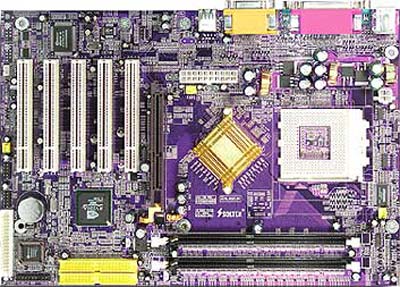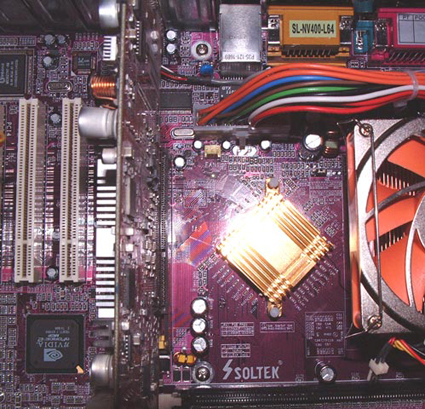Soltek NV400-L64: Purple, Practical, AND Performance!
by Wesley Fink on August 11, 2003 10:26 PM EST- Posted in
- Motherboards
Soltek NV400-L64: Board Layout
The Soltek has a decent layout for a low-end board. We say this because low-end boards often have some of the strangest layouts. When the manufacturer is aiming for a price point, economy of manufacture is often more important than ergonomics.
The first hint that the NV400-L64 may be a serious performer is the inclusion of both the standard 20-pin ATX connector and the AMD optional 4-pin 12V connector. While top-end AMD motherboards are implementing both of these standards, which are part of the Pentium 4 Power Supply specification, we were somewhat amazed to see both connectors on a value board. Regardless, the location of the 20-pin and the 4-pin power connectors are less than ideal. The 20-pin ATX is located to the left of the Northbridge chip, almost in the center of the board. This means you will have to snake the bulky 20-pin cable around your CPU socket and try to keep it from interfering with ventilation. We prefer a location as near to the top of the board as possible and to the right of the CPU. This works best in most case designs. The 4-pin 12V connector is in a common location, to the left of the CPU socket, but it is thankfully at the top of the board. While we prefer the 12V to the right of the CPU socket, between the CPU and DIMM slots and as close to the top of the board as possible, we can’t complain about Soltek’s positioning of the 12V connector — it does not interfere with air-flow or present cable-routing problems.
Fan connections are often in short supply on low-end boards, but Soltek includes three fan headers on the NV400-L64. This allows connection of up to three monitored fans to the board.

The passive heatsink used on the Northbridge has the advantage of not adding to system noise, but the one Soltek used on the NV400-L64 is much smaller than we have seen on other nForce2 boards. While it cooled effectively in our testing, it did get warmer than desired. Those planning any serious overclocking with this board may want to replace the Northbridge heatsink with a larger passive heatsink or an active cooling solution.
One advantage of a small passive or active Northbridge cooling solution is that it won’t interfere with mounting some of the larger CPU cooling solutions. There is plenty of room around the CPU socket, and we don’t believe mounting a large cooler on the CPU will create any problems. The Thermalright SK-7, which uses a clip for connection, fits with ease — even with an 80mm fan attached. However, there are no mounting holes around the CPU socket, which will be important to some. The mounting holes are not part of the current AMD specification, and we didn’t expect to find them on a value board, but they are important to many who use watercooling and very heavy heatsinks.
The Floppy connector and Primary/Secondary IDE connectors are all in compromised positions — predictable for a low-priced board. All three connectors are low on the board, which makes snaking cables more difficult. The floppy connector is in a particularly bad location, situated at the very bottom of the board. At least Soltek kept the connector to the far right of the board, which will minimize interference with slots. But Soltek is no worse than other low-end boards with respect to cable locations. A smaller board means less room to put things, and some of the small boards face some real challenges regarding layout. Our preference is closer to the top of the board, to the right of the DIMM slots; however the smaller board offers no room for the cable connections in that location.
If you have a case with drive bays to the right of the motherboard, the location of the IDE/Floppy connectors near the bottom right of the board will seem ideal. However, if your drives must mount in the upper bays of a tower case, you will probably hate the location of the IDE connectors. In the real world, users with full-tower cases will not likely choose a low-end board like the Soltek to go in their expensive cases. The Soltek layout, therfore, should work fine in the small to mid-size cases that will actually be used with this board.










35 Comments
View All Comments
epicstruggle - Tuesday, August 12, 2003 - link
is it just me or did the article replace ' with ’.later,
Anonymous User - Tuesday, August 12, 2003 - link
Good point for soltek board is they always unlock your high order XP cpus ;)Anonymous User - Tuesday, August 12, 2003 - link
I think the ASUS A7N8X-X also uses Single-Channel memory.Anonymous User - Tuesday, August 12, 2003 - link
What are you talking about, for $15 more than this board costs I can get a KT600 board that's equal or greater in performance with SATA (+RAID), Firewire, 8 USB 2.0 ports, and better onboard audio. Certainly wouldn't want people looking at that!Anonymous User - Tuesday, August 12, 2003 - link
Great bang for the buck! It should keep a lot of people from looking VIA's way.